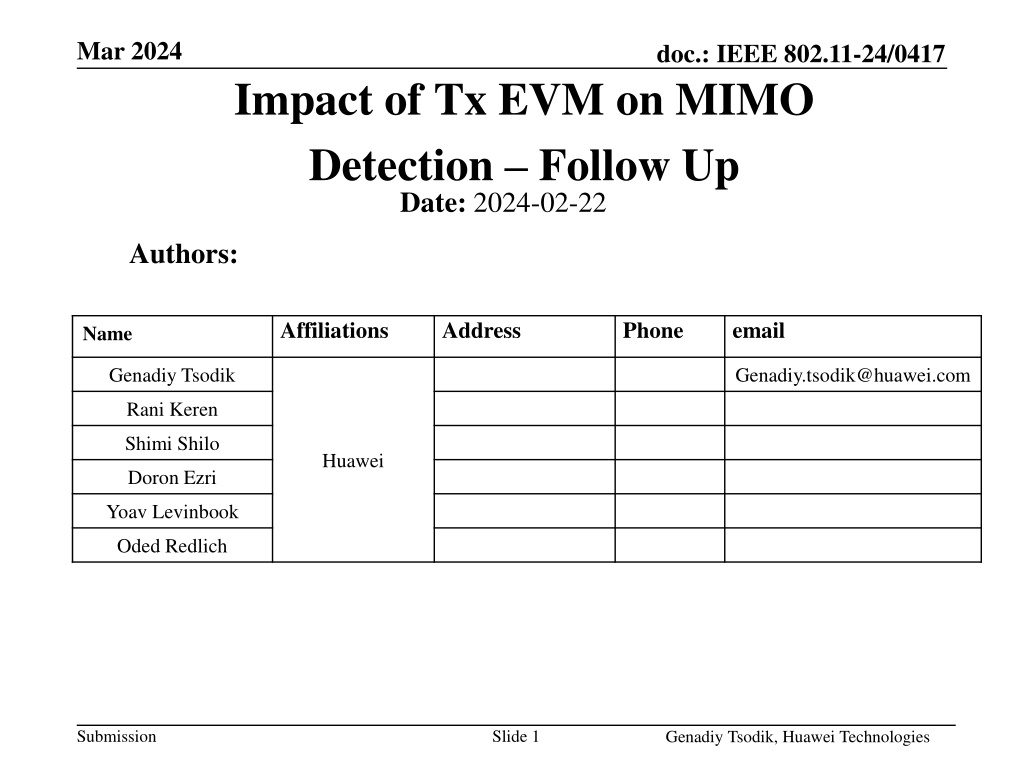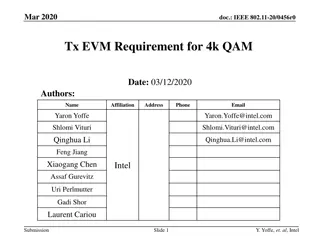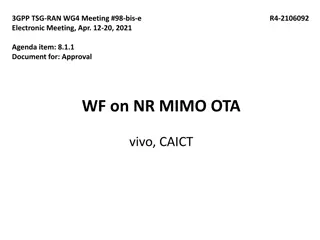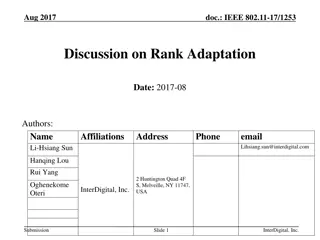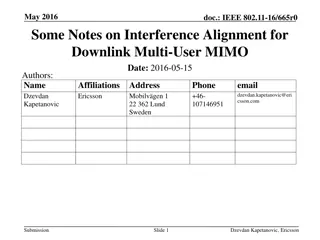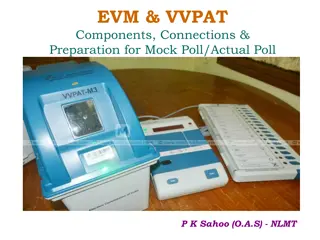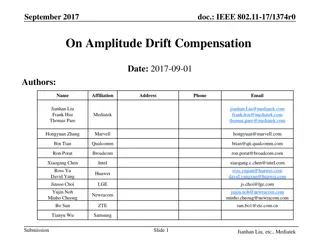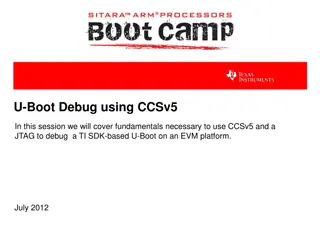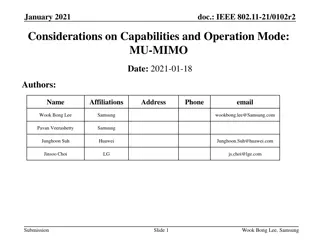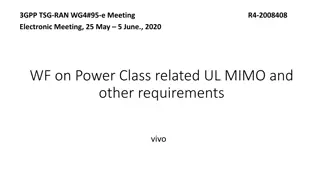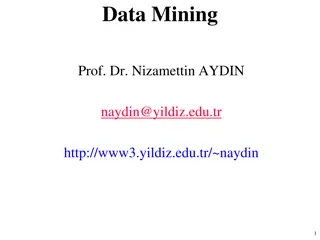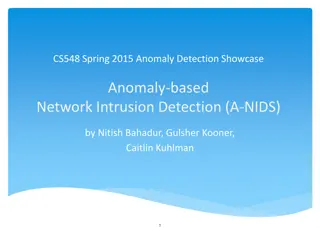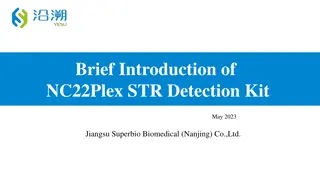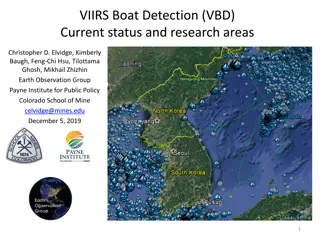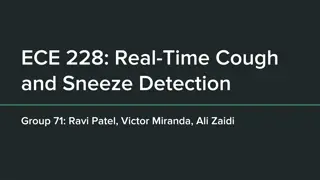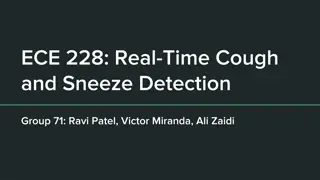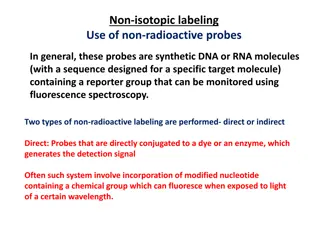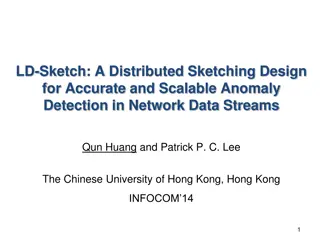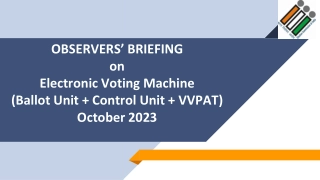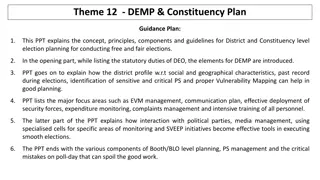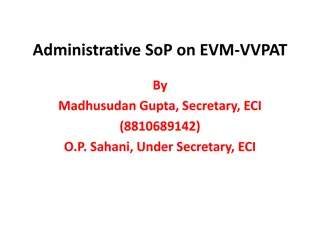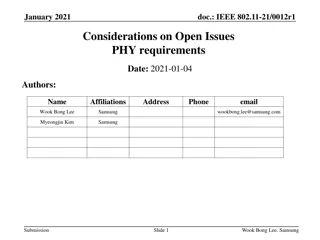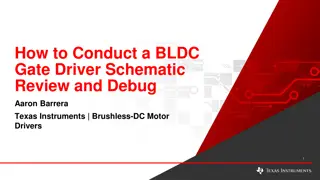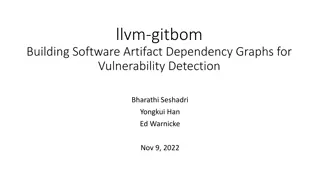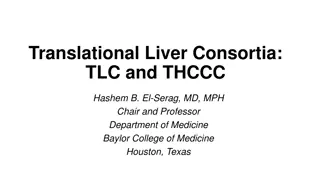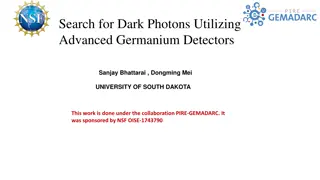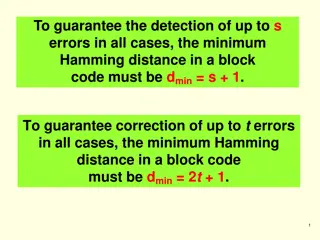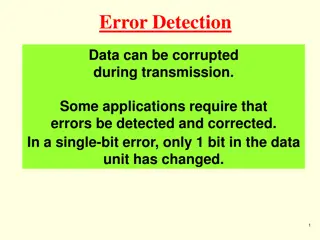Impact of Tx EVM on MIMO Detection Follow-Up
This document discusses the impact of Tx EVM on MIMO detection, highlighting that improving Tx EVM can achieve theoretical gains in nonlinear detection. It addresses questions raised during discussions and presents an optimal detector scenario in the presence of colored noise from Tx EVM. Simulation results show the performance degradation caused by bad Tx EVM and the improvement in detection with whitening.
Download Presentation

Please find below an Image/Link to download the presentation.
The content on the website is provided AS IS for your information and personal use only. It may not be sold, licensed, or shared on other websites without obtaining consent from the author. Download presentation by click this link. If you encounter any issues during the download, it is possible that the publisher has removed the file from their server.
E N D
Presentation Transcript
Mar 2024 doc.: IEEE 802.11-24/0417 Impact of Tx EVM on MIMO Detection Follow Up Date: 2024-02-22 Authors: Affiliations Address Phone email Name Genadiy Tsodik Genadiy.tsodik@huawei.com Rani Keren Shimi Shilo Huawei Doron Ezri Yoav Levinbook Oded Redlich Submission Slide 1 Genadiy Tsodik, Huawei Technologies
Mar 2024 doc.: IEEE 802.11-24/0417 Recap In [1] we presented the impact of Tx EVM on nonlinear MIMO detection We explained that the theoretical gain of nonlinear detection can not be achieved when Tx EVM is a dominant noise contributor MMSE outperforms ML! In particular, we showed that in this case the optimal detector coincides with linear detection which implies that linear detection outperforms nonlinear near-ML detection ? 1? ?2 ?ML= argmin ? QAM? We also showed that improving Tx EVM resolves the issue and achieves the theoretical gain of nonlinear detection In this contribution we address some questions that were raised during the discussion and provide further thoughts on this topic Submission Slide 2 Genadiy Tsodik, Huawei Technologies
Mar 2024 doc.: IEEE 802.11-24/0417 Optimal Detector As derived in [1], when transmitted signal has additional noise component produced by Tx EVM the noise at the receiver is colored = + s s w = + = + + y Hs n Hs Hw n Colored noise... It implies an optimal detector for this scenario which includes whitening stage with inverse Cholesky of the noise covariance 2 * 2 = + C HH I ( ) ( ) * 1 = s y Hs C y Hs argmin ML M QAM s It also means that in presence of Tx EVM performance is always degraded and transmit noise become a limiting factor (whitening can not compensate Tx EVM impact) we show the simulation results in the next slide Submission Slide 3 Genadiy Tsodik, Huawei Technologies
Mar 2024 Optimal Detector vs Tx EVM Improvement doc.: IEEE 802.11-24/0417 We can see on the figure below that bad Tx EVM may significantly degrade the performance of both linear and non-linear detector We compare the best performance that can be achieved with improved Tx EVM when applying near-ML and MMSE to the optimal near-ML + whitening detectors We can see that improving Tx EVM yields gain of 2dB compared to optimal detection with a whitening stage (of course the latter requires a higher complexity at the receiver) 2dB Whitening in this simulation is based on genie transmitter noise covariance Submission Slide 4 Genadiy Tsodik, Huawei Technologies
Mar 2024 doc.: IEEE 802.11-24/0417 Impact of Tx EVM with different MCS We also examined the impact of Tx EVM on the performance of different modulations and coding rates Simulation parameters: TGn-D channel Modulation and coding rate: MCS4, MCS5, MCS8, MCS9 4 STAs Nss = 1 per STA Nrx_Ant = 4 PA Model Rapp, p = 2 Detector MMSE and near-ML (with no whitening) OBO we show two results for each type of detector: The minimum OBO that ensures standard Tx EVM requirement is met The OBO that implies best performance at PER = 10% Submission Slide 5 Genadiy Tsodik, Huawei Technologies
Mar 2024 doc.: IEEE 802.11-24/0417 Mid MCS We can see that the best detection with improved Tx EVM is better then the best detection at standard Tx EVM by up to 8dB The improved Tx EVM implies better performance for both MMSE and near-ML detection, while nonlinear detection yields a significant gain compared to MMSE detection 7dB 8dB Submission Slide 6 Genadiy Tsodik, Huawei Technologies
Mar 2024 doc.: IEEE 802.11-24/0417 High MCS MCS8 We can see similar behavior at high MCS where both detectors provide significant improvement with better Tx EVM, while the near-ML detector also yields a significant gain compared with the MMSE detector 3dB 5dB Slide 7 Submission Genadiy Tsodik, Huawei Technologies
Mar 2024 doc.: IEEE 802.11-24/0417 High MCS MCS9 MCS9 behaves similar to MCS8, where with full rank MIMO there is a much higher gain 3.5dB 8dB Submission Slide 8 Genadiy Tsodik, Huawei Technologies
Mar 2024 doc.: IEEE 802.11-24/0417 Very High MCS We also simulated MIMO with MCS11 to study the impact of Tx EVM when SNR is very high and the theoretical gap between linear and nonlinear detector is smaller We can see that the gain of near-ML detection is smaller (~1dB), however we still achieve significant gain of 11dB compared to standard Tx EVM 11dB Submission Slide 9 Genadiy Tsodik, Huawei Technologies
Mar 2024 doc.: IEEE 802.11-24/0417 More Linear PA: Rapp with P = 6.5 A more linear PA enables lower BO while yielding the same Tx EVM, which means that near-ML may achieve its optimal performance at a lower BO level The gain of near-ML detection remains large and similar to the gain of 6dB that was observed with p = 2, while the gain between the best performing detector with standard and improved Tx EVM is 10dB 10dB Submission Slide 10 Genadiy Tsodik, Huawei Technologies
Mar 2024 doc.: IEEE 802.11-24/0417 Volterra based PA model As an alternative to the Rapp model, we also used a Volterra based PA model to incorporate the transmit signal impairments applied to the simulation. The Volterra model has the following advantages over the Rapp model: It is capable of incorporating the PA memory effects that are combined with the nonlinear effects It is a general model that can be tuned to accurately represent the behavior of a specific PA The Volterra model parameters were fitted to true recordings of output signal samples generated by a practical PA The PA recordings were extracted by a lab setup that includes signal generation and sampling instruments Submission Slide 11 Genadiy Tsodik, Huawei Technologies
Mar 2024 doc.: IEEE 802.11-24/0417 Volterra based PA model We can see on the figure below that the gain of the best detection with improved Tx EVM compared to the best detection with standard Tx EVM is ~4.5dB 4.5dB Submission Slide 12 Genadiy Tsodik, Huawei Technologies
Mar 2024 doc.: IEEE 802.11-24/0417 Summary We showed that improved Tx EVM has a significant impact on MIMO performance especially when non-linear detection is applied We can see impressive gain achieved with improved Tx EVM, both with different modulation and coding rates and also with a more realistic (more linear) PA model We also explained and showed that improved Tx EVM leads to better performance with a nonlinear detectors without a whitening stage than the optimal detector (using a whitening stage) while later also requires higher complexity Based on [1] and the results presented here we may consider modifying/extending standard Tx EVM requirements to improve MIMO performance and allow better adjustment to detector type applied at the receiver Submission Slide 13 Genadiy Tsodik, Huawei Technologies
Mar 2024 doc.: IEEE 802.11-24/0417 Reference [1] 11-23-1944-01-00bn-impact-of-tx-evm-on-mimo-detection Submission Slide 14 Genadiy Tsodik, Huawei Technologies
